Manchester City Women are one of the favourites for the title, but they have had a stuttering start to this WSL season, with draws against Brighton and Hove Albion Women and Reading Women, as well as a loss to defending champions Chelsea Women, all on their results list so far. However, this game against the league’s bottom side, Bristol City Women, offered them a chance to put on a good performance and increase their goal difference, such is the situation that Bristol find themselves in. This tactical analysis will look at Manchester City’s attack and Bristol’s defence, as Bristol didn’t attack much and Manchester City’s defence had a quiet afternoon. The analysis will look at how Bristol gave Manchester City so many chances to score, and we will also analyse the role of the holding midfielder in the home side’s overall attacking tactics.
Lineups

Manchester City Women made just two changes from the team that drew away at Reading in their last game. Left-back Alex Greenwood, who featured as a centre-back in that game, moved back to left-back with her England teammate Demi Stokes making way for her in that position; Stokes was left out altogether. The other change saw USA midfielder Rose Lavelle move to the bench, with Laura Coombs coming off the bench to take her place. Georgia Stanway, who started this season as a false nine, was again deployed as the left-sided attacker, with her England teammate Ellen White given the striker role.
Bristol City Women, meanwhile, had a hugely depleted squad, with coronavirus meaning that five first-team players, Charlie Wellings, Gemma Evans, Ella Mastrantonio, Abi Harrison, and Meaghan Sargeant, were all in self-isolation. As a result, Bristol boss Tanya Oxtoby had to make five changes to the starting XI that lost at home to Birmingham City Women in their last WSL match, with another absentee being Aimee Palmer, who was injured during that game. Belgium’s former Liverpool Women forward Yana Daniels came in at right-back, with Florence Allen, Jasmine Matthews, and Naomi Layzell forming a central defensive trio. On-loan Brighton defender Laura Rafferty played in midfield, whilst Emma Bissell and Australia midfielder Chloe Logarzo acted as the wingers. Ebony Salmon was asked to play at the top of the pitch by herself, with Bristol looking to defend as much as possible against their hosts.
Manchester City Women’s attack
The first thing that we will look at is Manchester City Women’s attack. We know that they like to play in a 4-3-3 formation, which allows them to spread across the pitch.

That is what we can see in the image above, and it gave us an idea of how they were going to approach this game. Bristol City Women had a very inexperienced defensive line, and Manchester City were obviously looking to exploit this by forcing gaps to appear between them. Ellen White is their danger player, and it was clearly the aim to give her as much space as possible in the central areas to cause problems for Bristol.

However, in order to get the ball into White, they needed players on the wings who could get the ball into the box. A common feature of Manchester City’s game is to get their full-backs as high up the pitch as possible, supporting the attackers, and enabling the wider forwards to cut inside and support the central striker. England internationals Lucy Bronze and Alex Greenwood bring that attacking edge to the team, and here we can see how Bronze has got herself into the goal area to set up a shooting opportunity.
The interesting thing about this image is that it shows how Manchester City weren’t just putting crosses into the box, but were also dribbling the ball into the central areas before pulling it back for teammates to shoot from, mixing up how they were delivering the ball into the central players. This was a constant feature of their game in the first half, so it was clearly something manager Gareth Taylor had been working on with his team. The likely reason for this was to take advantage of Bristol’s patched up defence, working their way through the gaps and getting into the space behind them as often as possible.
You can also see how, because Lucy Bronze is the one with the ball, Manchester City have been able to overload the box with players, offering plenty of passing options to the England full-back. Therefore, this shows how Manchester City’s attacking full-back tactic helped them to create chances and put pressure on Bristol’s defence.
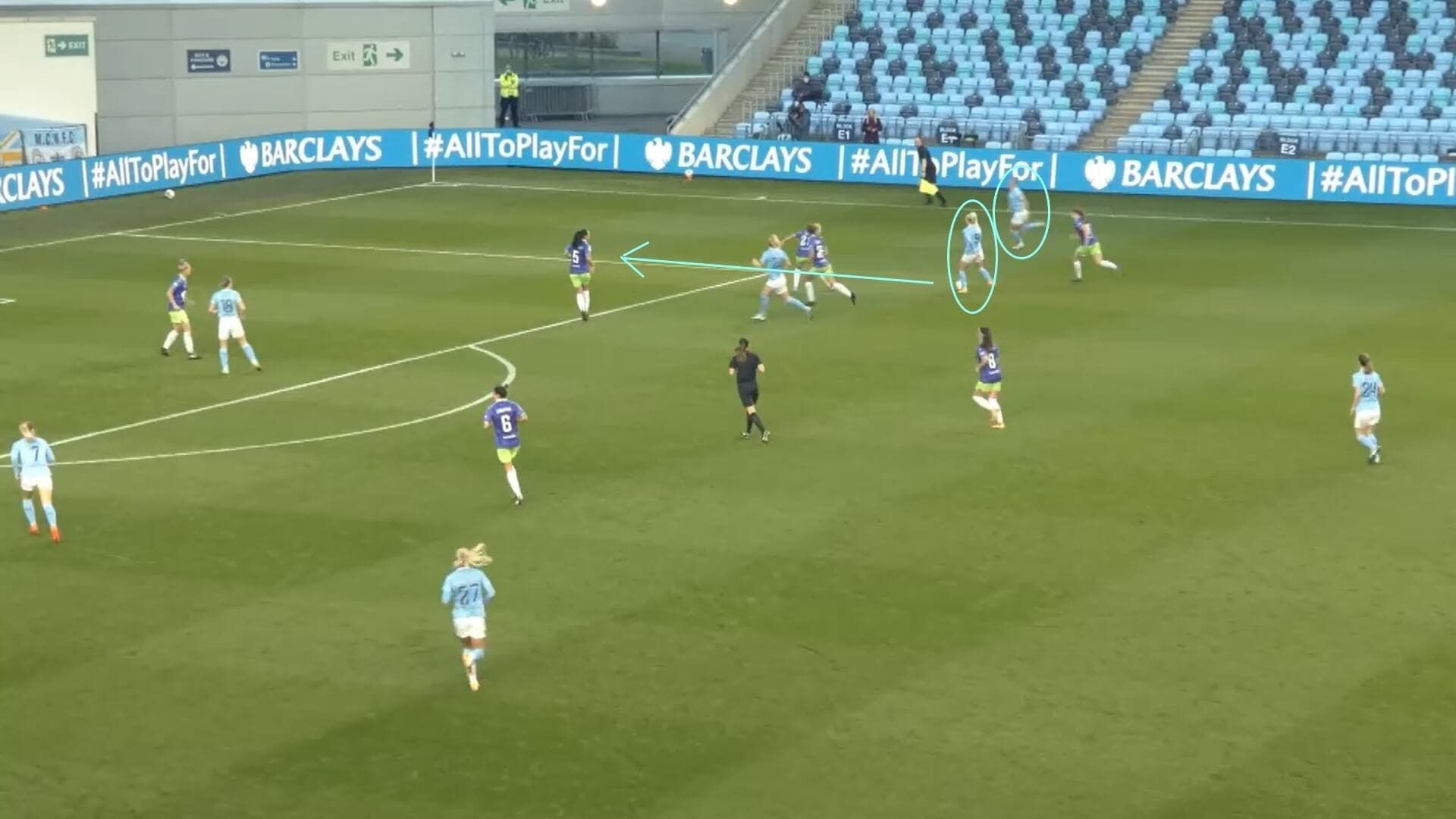
Their wing play was a constant feature of their game. Here, we can see how in the second half, they continued to push their full-backs up the pitch, overlapping the wingers, and this overload allowed them to create 2-v-1 situations in the wider areas. We will come onto why they could do this later on, but it shows us another reason that Manchester City’s full-backs are so important to their attacking success because they offer a backup option for getting the ball into the central attackers when the wingers can’t, as well as giving the wingers more freedom to move around the final third and create problems for the opposition. In this particular game, this tactic was used as another way of putting pressure on the Bristol defenders.

Making short passes on the wings is not always a strength of their game. We saw instances last season of how it could be unreliable, and this is another example of that. Ellen White is looking to set the cross up for Alex Greenwood here, which would create a chance for Sam Mewis, who is waiting for the ball to come into the box. However, the pass from White is too hard, and goes too far, meaning Greenwood can’t get to it. In this game, it didn’t matter so much, but against other teams, it is a big reason why Manchester City have struggled to make their attacking moves count.
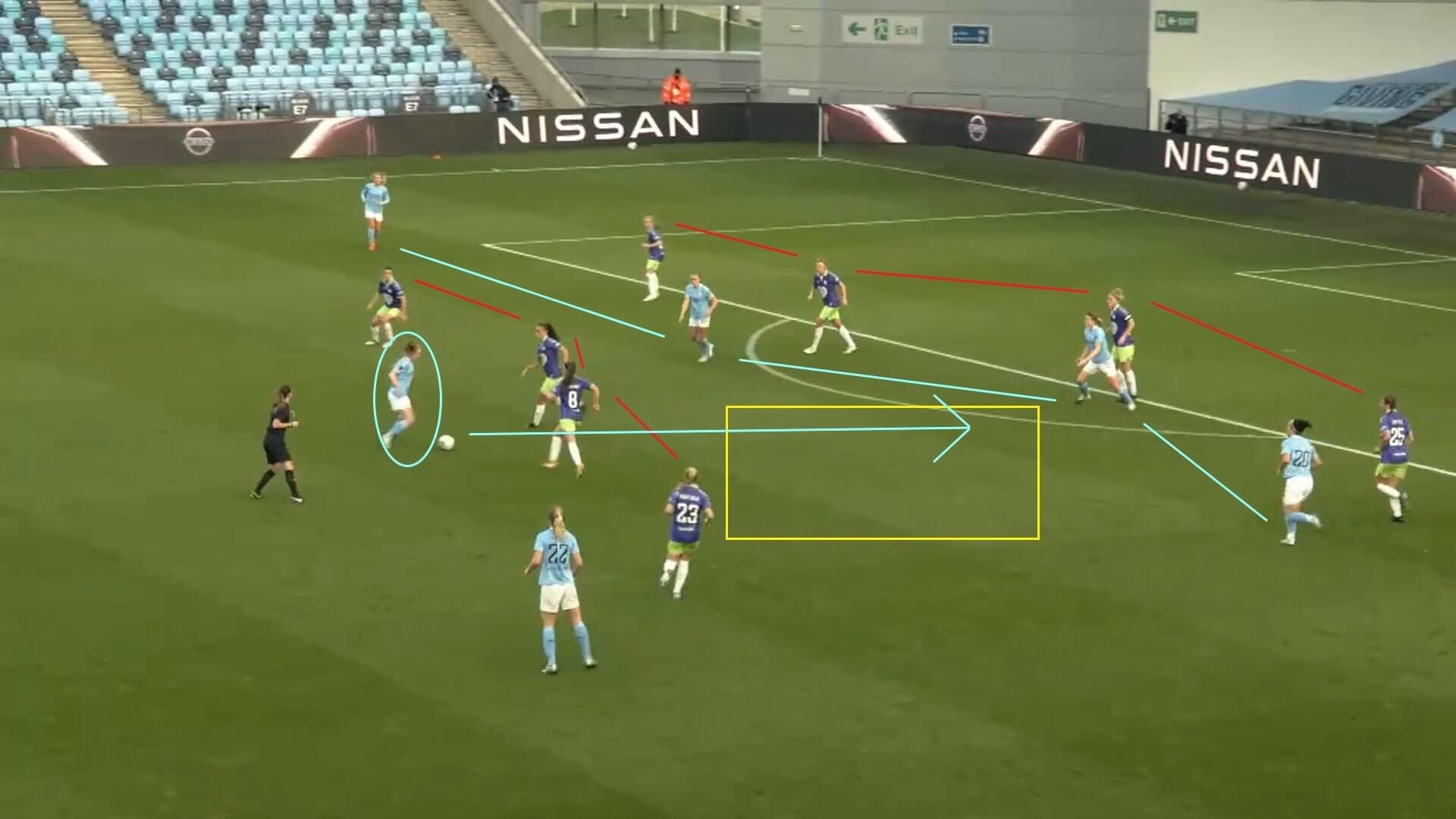
We have looked at how Manchester City used the wider areas to get the ball into the box in different ways, creating plenty of problems for Bristol. However, it was also notable that they had tactics for attacking centrally, as can be seen in this image. Here, Keira Walsh, in the blue circle, has the ball but it initially looks like she has no space to move into because Bristol have two lines set up, as shown by the red lines. However, Manchester City’s forward players, marked by the blue lines, move away from Walsh, which then forces Bristol’s back line away from the ball, as they have to cover those passing options. Therefore, Manchester City have forced the two Bristol lines away from each other, creating space in between, which is marked by the yellow box.
Now with this new space, Walsh can move the ball forwards, and she passes to Ellen White, who then lays it off for Walsh to score from, making it Manchester City’s third goal of the afternoon.
This situation shows us two key things. Firstly, Bristol had clearly come to the Academy Stadium with the intention of staying back and not conceding too many goals, and their defensive shape in this image shows how they looked to do that. Secondly, and we have seen this in previous images too, Manchester City had the tactics and players to break Bristol down, and this was what enabled them to go on and win the game.
Bristol City Women’s defensive mistakes
As we have mentioned, Bristol City Women’s clear aim for this game was to sit back and defend, aiming to concede as few goals as possible. The image below shows how their structure reflected that.

You can see how there are two clear lines of Bristol defenders, which has forced Manchester City Women to play the ball into wider areas, and the first half did see a lot of sideways passes from the home side, as they looked to find a way around this structure. It is harder to stop attacks centrally than it is to stop them coming from the wings because crosses can be blocked, and so when in this formation, Bristol stood a chance of getting something from the game. You can see how Manchester City’s central attackers are looking to get into the space behind, where the ball is, but are having trouble doing so. Meanwhile, there is no support from the midfield because they are stuck behind the second Bristol line. Therefore, we can see how Bristol looked to frustrate their hosts.

The main difference between that situation and this one is that, in the previous image, Bristol were spread out, organised, and all working together to block off as much space as possible. In this image, we can see in the yellow box how the Bristol defenders have all narrowed together, bunching up in the central areas of the pitch. This has left enormous gaps between those defenders and the wide midfielders, as the red lines show, and has therefore opened up the space behind for Manchester City to get their wider attackers into. As the blue arrow demonstrates, Lucy Bronze, in the blue circle, sees this and makes the pass through, giving Chloe Kelly, in the blue square, an easy opportunity to reach it and get the cross into the box.
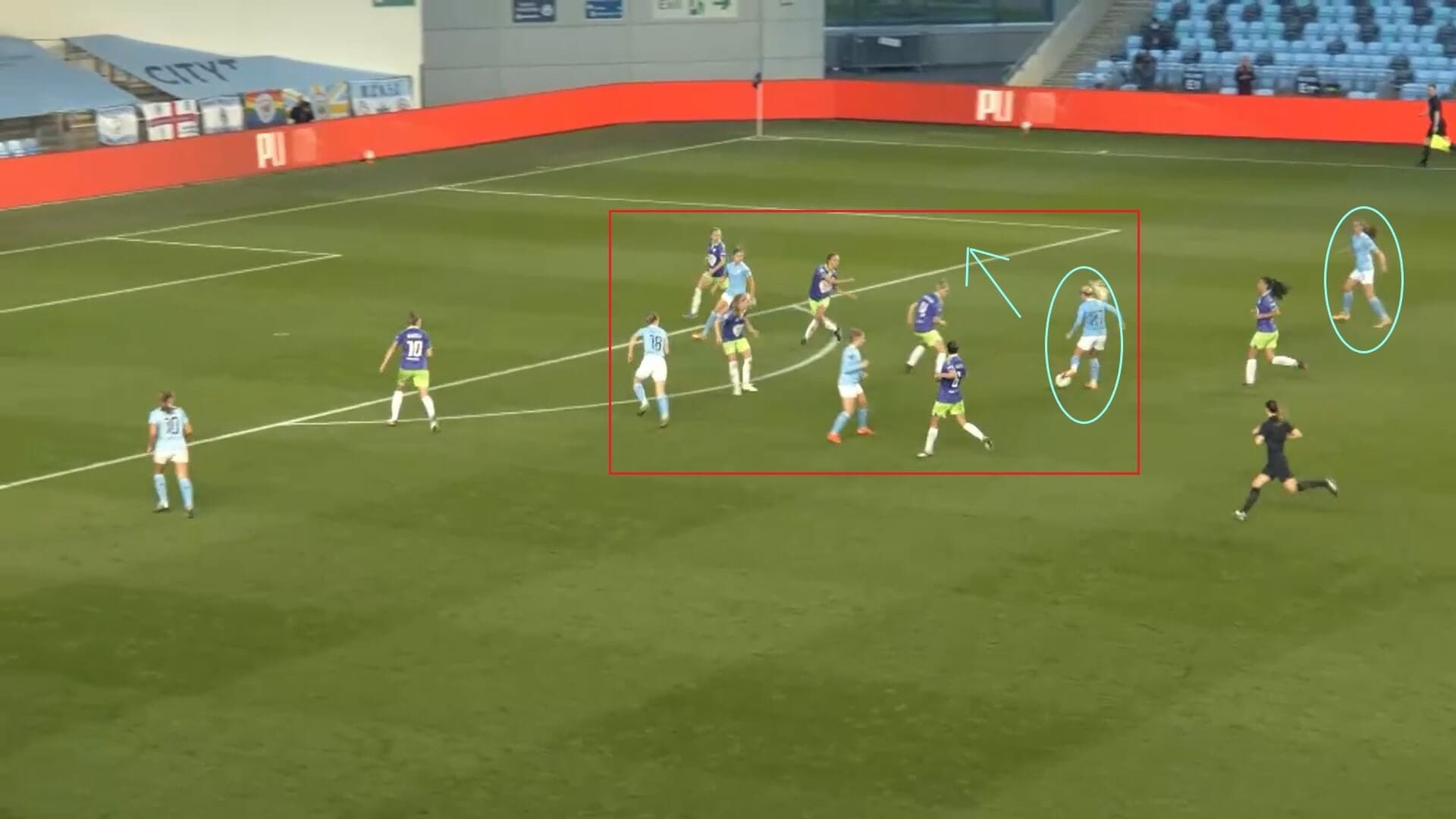
The same thing was happening in the second half too, as is shown in this image. This time, it’s Alex Greenwood who has the ball, and she passes it out to the wings, outside the Bristol defence, to where substitute Canada winger Janine Beckie, in the other blue circle, can reach it. Again, we can see how Bristol’s defenders have all moved inside the pitch, giving Manchester City the opportunity to get the ball behind them, before then crossing it into the box. At least two of Manchester City’s goals came from these situations, with Ellen White scoring from a pass across the goal before Beckie got one for herself late on with a direct strike from the wing. If we compare this to the first image, we can see just how Manchester City would have found it harder to create and score so many chances if Bristol had kept their early shape. It should be remembered that this was a very inexperienced Bristol side, but they needed to have more confidence in themselves to hold their early defensive structure, which was set up well.
Manchester’s City Women’s holding midfielder role
We have looked at Manchester City Women’s attack and the reasons from Bristol City Women’s point of view why they were able to play so freely and score so many. However, the role in Manchester City’s team that actually enables them to throw so many players forward is the holding midfield role.
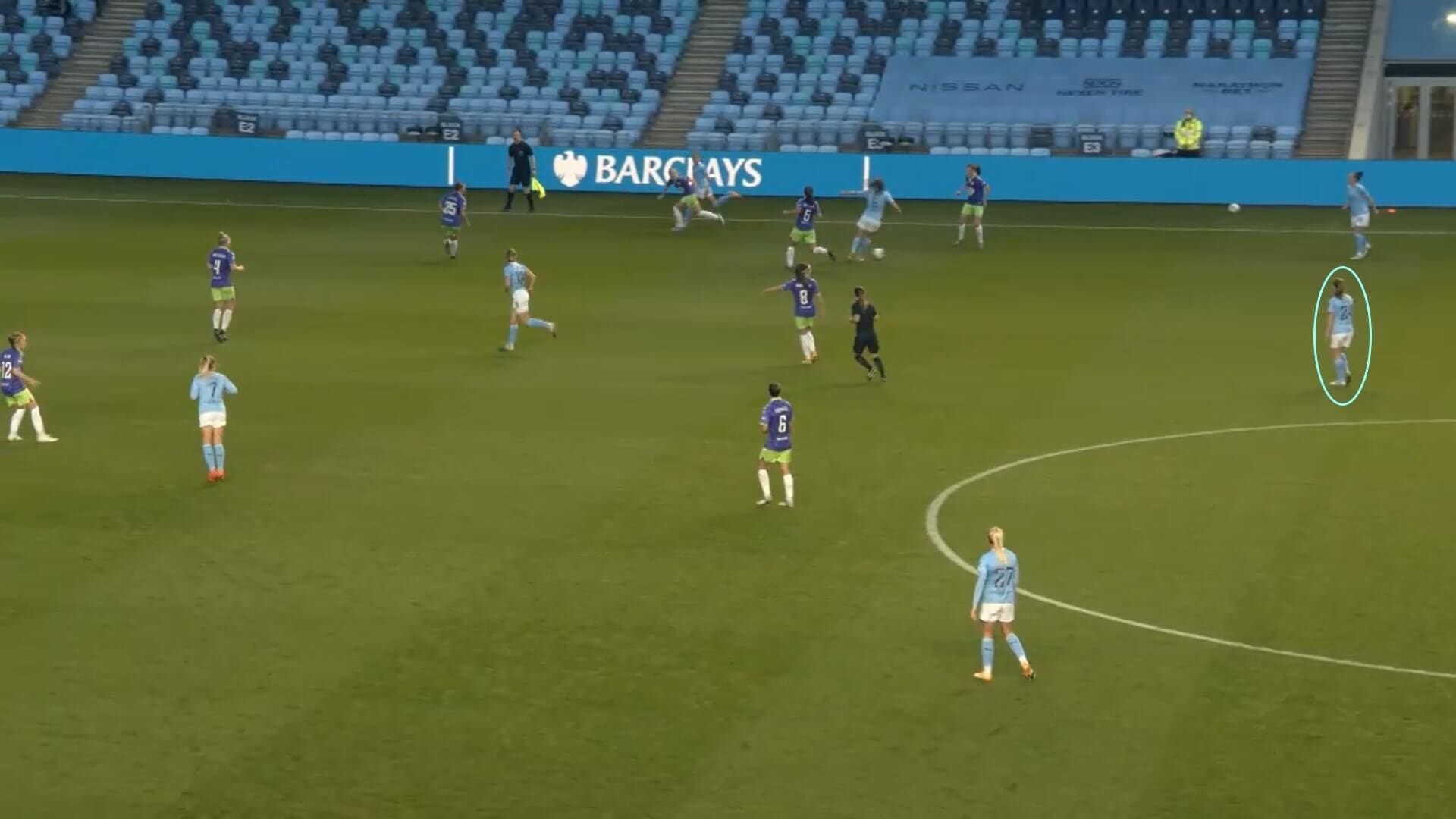
Keira Walsh is usually the player tasked with this role, and she is therefore an underrated player compared to her teammates, and a player not talked about as often. However, in this image, we can see the effect that her positioning, in the blue circle, has on her team’s attack. We can see how she doesn’t make the run forward, and instead sits behind the main forward players. This ensures that protection is available for the defence, in case the opponents launch a counter-attack. Therefore, with this in mind, the other midfielders (Laura Coombs and Sam Mewis in this game) can then get forward and play as creative attacking options in the final third. This increases the number of players in the attack, and therefore the chance of Manchester City scoring.
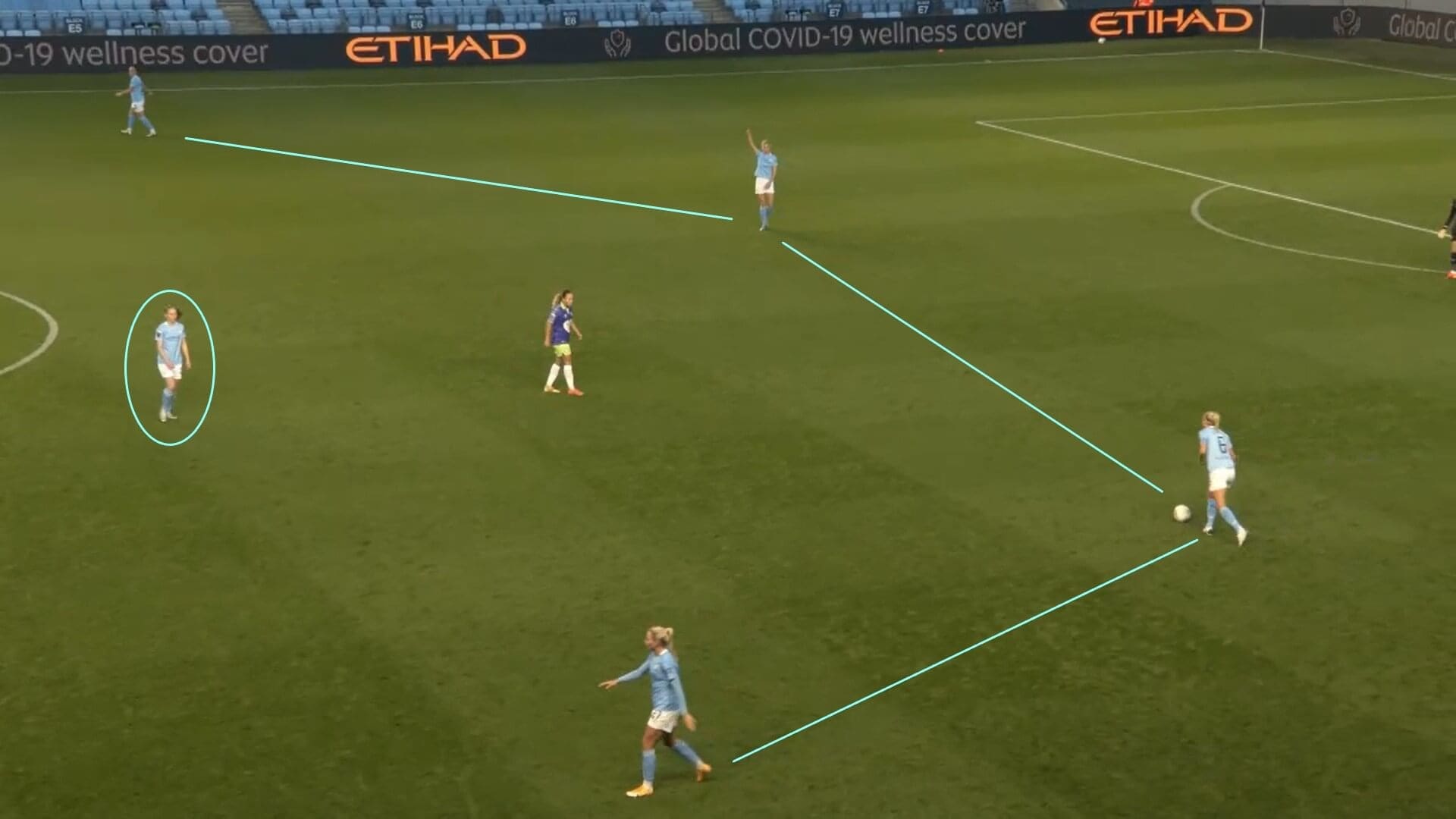
However, the role of Manchester City’s holding midfielder is more than just protecting the defence. Walsh, in particular, is the one who links up the defence and attack, and here we can see how the defence has a solid, organised structure, with Walsh offering herself as a passing option if it is needed. Captain Steph Houghton has the ball, and she tends to play long passes where she can, but Walsh’s presence ensures that there is a shorter passing option if needed.
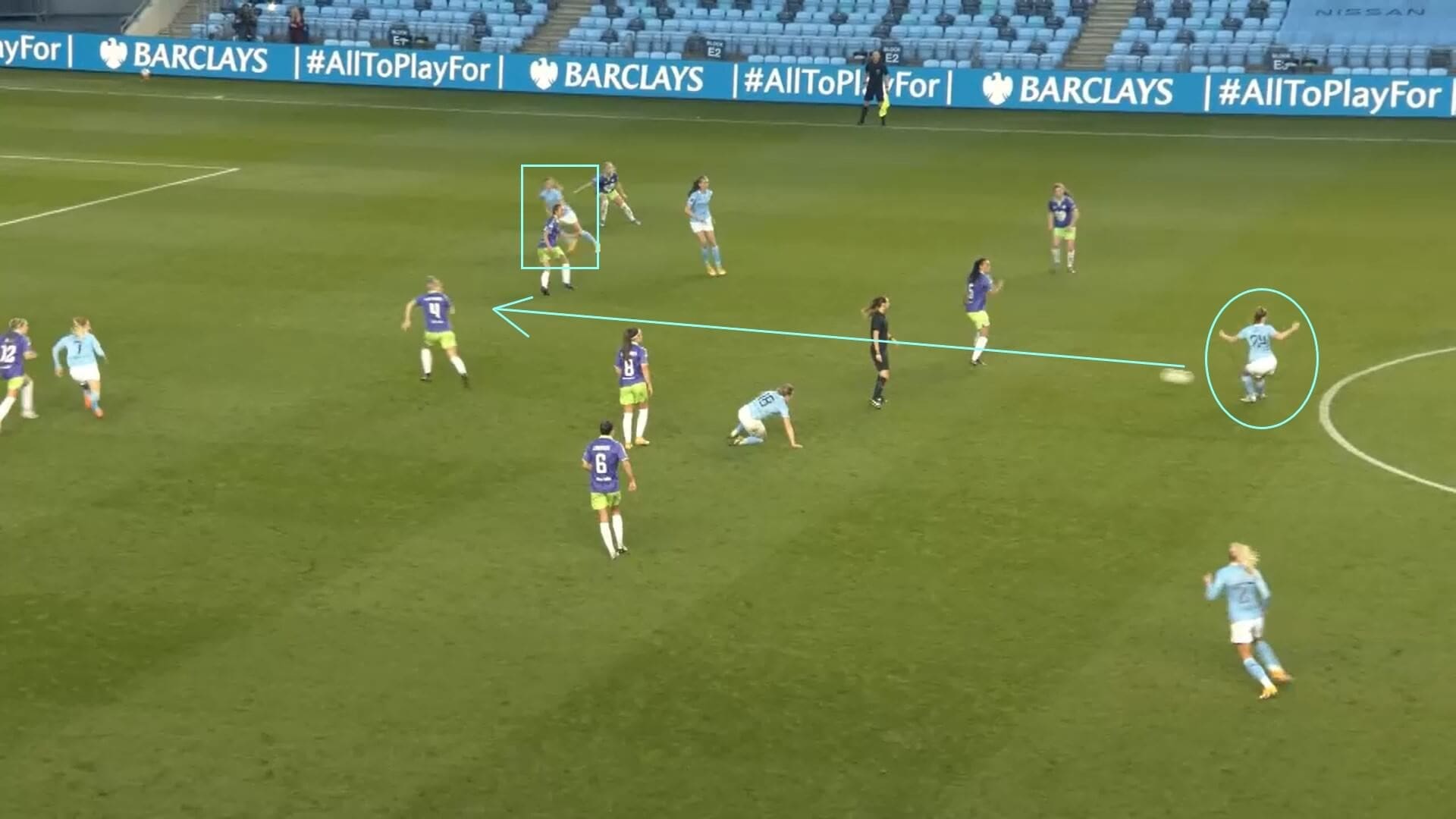
When she gets the ball, she can then take it forward and find her teammates in spaces. Here, we can see how her positioning opens up plenty of long and short passing options, and Bristol won’t be able to cut them all off. Walsh has played a pinpoint pass through the middle here, finding Beckie, who has angled her body to ensure she can meet the ball when it emerges behind the Bristol defence. Walsh has a good passing range, and a good intelligence of when each pass can be made, and that is another reason that her role in the team, linking up the play in this way, is so central to Manchester City’s attack.
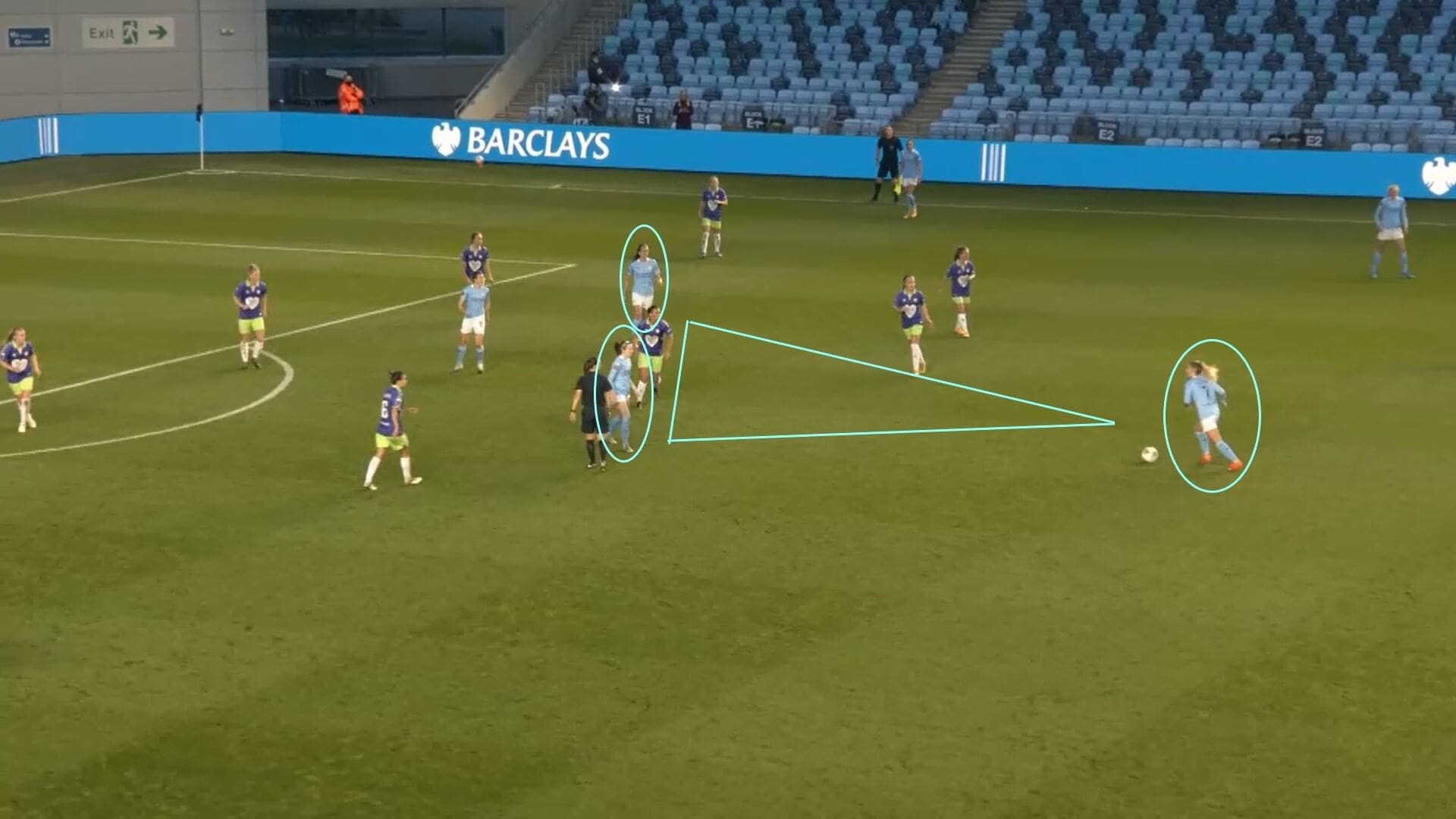
Walsh was substituted off in the second half, with Scotland attacking midfielder Caroline Weir coming on in her place; Laura Coombs moved back to take over Walsh’s role. In this image, we can see Coombs’ positioning in comparison to Jill Scott, who had earlier replaced Sam Mewis, as well as Weir, and the triangle indicates again how having a holding midfielder in these areas enables the other midfielders to get forward and support the attack, and how much the midfield line that they start with quickly becomes more attack-minded.
What we have shown in this section is that, whilst the wingers, full-backs, and strikers often get the praise for creating chances and scoring goals, the only reason that Manchester City are able to be so attacking is because of the insurance that they have from the likes of Keira Walsh and Laura Coombs further back, protecting the defence and linking up the play.
Conclusion
In conclusion, this tactical analysis has shown the reasons why Bristol City Women struggled to contain Manchester City Women in this game, despite setting up with the aim of doing so, and why Manchester City were able to take control, using a variety of tactics to help them find and create spaces in Bristol’s defence. We have also looked at one of the lesser-analysed areas of Manchester City’s team, which is the holding midfield role, usually filled by Keira Walsh, and why it enables Manchester City to attack the way they do.
Women’s Football Weekend hits us next Saturday and Sunday, with Manchester City travelling to city rivals Manchester United Women for the first Manchester derby of the season, whilst Bristol City Women entertain Tottenham Hotspur Women, another side struggling for form and confidence.





Comments